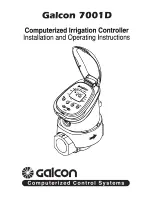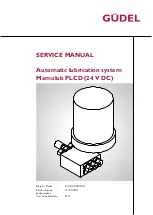
FCI WATERMAKERS, INC.
5
FCI WATERMAKERS, INC.
General
BOUNDARY LAYER / CONCENTRATION POLARIZATION
When water permeates through the membrane, nearly all the salt is left
behind in the brine channel. In any dynamic hydraulic system, the fluid
adjacent to the wall of the vessel is moving relatively slow. Even though
the main body of the stream is turbulent, a thin film adjacent to the wall
(membrane) is laminar. This thin film is called the boundary layer.
If the feed water flow is insufficient, the salts are saturated at the boundary layer
and can readily adhere to and pack into the R.O. membrane element surface.
For this reason, it is important to maintain sufficient feed water flow through
the R.O. membrane element and prevent concentration polarization.
BRINE VELOCITY
The brine velocity, or flow, over the membrane surface is very important
to both product water quality and quantity. At low flows, concentration
polarization occurs, causing the water quality to decline.
In addition to inferior product water quality, low brine flows can
increase the precipitation of sparingly soluble salts. The salts will foul
the R.O. membrane element surface (concentration polarization). If
this occurs, the product water flux (production) will decline.
The feed pump integrated design provides a relatively smooth and continual
flow of feed water across and through the R.O. membrane element.
COMPACTION
Some densification of the membrane structure may take place while operating
at elevated pressures, above 1000 PSI. The change is known as compaction
and is accompanied by a reduction in the water permeation rate.
When the R.O. membrane element is subjected to elevated pressures
beyond 1000 PSI, the product water channel becomes squeezed,
resulting in restriction and product water recovery reduction.
OSMOTIC PRESSURE
The transfer of the water from one side of the membrane to the other will
continue until the head (pressure) is great enough to prevent any net transfer
of the solvent (water) to the more concentrated (feed water) solution.
At equilibrium, the quantity of water passing in either direction is equal,
and the head pressure is then defined as the "osmotic pressure" of the
solution having that particular concentration of dissolved solids.
Following terms are helpful in becoming familiar with
a FCI Watermakers Reverse Osmosis System.
GLOSSARY OF TERMS
Summary of Contents for MAX-Q+
Page 1: ......
Page 2: ......
Page 16: ......
Page 22: ......
Page 26: ......
Page 31: ......
Page 32: ......
Page 33: ......
Page 34: ......
Page 35: ......
Page 36: ......
Page 37: ......
Page 38: ......
Page 40: ......
Page 41: ......
Page 42: ......
Page 45: ......
Page 46: ......
Page 47: ......
Page 50: ......
Page 51: ......
Page 52: ......
Page 53: ......
Page 54: ......
Page 55: ......
Page 56: ......
Page 57: ......
Page 58: ......
Page 62: ......
Page 72: ......
Page 87: ......
Page 108: ......
Page 113: ......
Page 115: ......
Page 117: ......
Page 122: ......
Page 130: ......
Page 136: ......
Page 137: ......
Page 138: ......
Page 139: ......
Page 140: ......
Page 141: ......
Page 142: ......
Page 143: ......
Page 144: ......
Page 145: ......
Page 146: ......
Page 147: ......
Page 148: ......
Page 149: ......
Page 150: ......
Page 151: ......
Page 152: ......
Page 153: ......
Page 154: ......
Page 155: ......
Page 156: ......
Page 157: ......
Page 158: ......
Page 159: ......
Page 160: ......
Page 161: ......
Page 162: ......
Page 163: ......
Page 164: ......
Page 165: ......
Page 166: ......
Page 167: ......
Page 169: ......






































